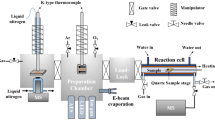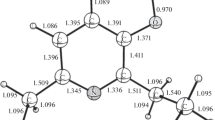Abstract
The dynamic exchange of hydrogen and deuterium is used to determine metal surface areas of solid catalysts. The measurements are carried out in situ, i.e. no transfer of the catalyst from the catalytic reactor to a probing chemisorption device is necessary. This makes the method suitable for measurements at any instant of catalyst activation or kinetic testing. The principle of operation is to perform gas switches from H2 to D2 (deuterium) at various hydrogen partial pressures under dynamic flow conditions using Ar as balance. When switching the gas, D2 reacts with the adsorbed H atoms and with H2 remaining in the gas phase, producing HD molecules. The exchange is followed mass spectrometrically. A linear relationship between the number of detected HD molecules and the hydrogen partial pressure is observed. The extrapolation to \({\text{p}}_{{{\text{H}}_{2} }}\) = 0 gives access to the number of H atoms adsorbed on the catalyst surface before switching gases. Provided the hydrogen/metal adsorption stoichiometry is known the specific surface area of the metal can be determined. This approach is methodically new and has been validated by comparing the surface areas of pure metallic Co samples (without any support) and their BET surface areas from measurements in the same experimental set-up. We finally demonstrate the usefulness of the methodical approach to determine “active” surface areas of Co-based catalysts after various pretreatments and kinetic tests.
Graphical Abstract




Similar content being viewed by others
References
Schweicher J, Bundhoo A, Kruse N (2012) J Am Chem Soc 134(39):16135–16138
Bundhoo A, Schweicher J, Frennet A, Kruse N (2009) J Phys Chem C 113(24):10731–10739
Iablokov V, Beaumont SK, Alayoglu S, Pushkarev VV, Specht C, Gao J, Alivisatos AP, Kruse N, Somorjai GA (2012) Nano Lett 12(6):3091–3096
Iablokov V, Meffre A, Chaudret B, Kruse N (in preparation)
Xiang Y, Chitry V, Liddicoat P, Felfer P, Cairney J, Ringer S, Kruse N (2013) J Am Chem Soc 135(19):7114–7117
Frennet A, Visart de Bocarmé T, Bastin J-M, Kruse N (2005) J Phys Chem B 109(6):2350–2359
Frennet A, Chitry V, Kruse N (2002) Appl Catal A 229(1–2):273–281
Engel T, Ertl G (1982) In: King DA, Woodruff DP (eds) The chemical physics of solid surfaces and heterogeneous catalysis, 4th edn. Elsevier, Amsterdam
Reuel RC, Bartholomew CH (1984) J Catal 85(1):63–77
Pascal P (1963) Nouveau traité de chimie minérale. Masson et Cie, Paris
Dus R, Lisowski W (1976) Surf Sci 61(2):635–645
Morris MA, Bowker M, King DA (1984) In: Compton RG (ed) Simple processes at the gas–solid interface, 19th edn. Elsevier, Salt Lake
Gregg SJ, Sing KSW (1967) Adsorption, surface area and porosity. Academic Press, London
Beitel GA, Laskov A, Oosterbeek H, Kuipers EW (1996) J Phys Chem 100(30):12494–12502
Bundhoo A, Schweicher J, Frennet A, Kruse N (in preparation)
Shafer WD, Jacobs G, Davis BH (2012) ACS Catal 2(7):1452–1456
Kip BJ, Duivenvoorden FBM, Koningsberger DC, Prins R (1987) J Catal 105(1):26–38
Acknowledgments
This work was financially supported by FRIA of the Belgian National Research Council FNRS (PhD grants for J.S. and A.B.) which is gratefully acknowledged. J.S. and A.B. also acknowledge the Fonds David et Alice Van Buuren. We are also thankful for support by Shell Global Solutions.
Author information
Authors and Affiliations
Corresponding author
Electronic supplementary material
Below is the link to the electronic supplementary material.
Rights and permissions
About this article
Cite this article
Schweicher, J., Bundhoo, A., Frennet, A. et al. Dynamic Hydrogen–Deuterium Exchange to Determine Metallic Surface Areas of Catalysts. Catal Lett 144, 204–210 (2014). https://doi.org/10.1007/s10562-013-1161-9
Received:
Accepted:
Published:
Issue Date:
DOI: https://doi.org/10.1007/s10562-013-1161-9




